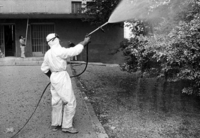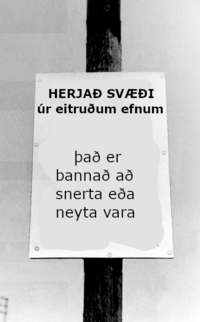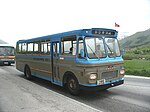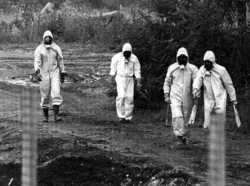Setberg disaster
| |
| Native name | Setberg stórslys |
|---|---|
| Date | 8 August 1979 |
| Time | 23:34 (AMT+05:00) |
| Venue | Setberg Chemical Plant |
| Location | Setberg, Reykanes |
| Also known as | 8/8 |
| Type | Industrial accident Chemical accident |
| Cause | Fire |
| Deaths | 945 |
| Non-fatal injuries | 253 |
Setberg disaster,commonly called 8/8, was a industrial accident and a chemical accident that occured on the night of 7 August 1979 in a small town called Setberg located 3 kilometers from Hafnir in the Hafnir Municipality with a population about 20,000 near Hafnir at the time of the disaster. Today it is located in the agglomeration of Hafnir. When a fire broke out and heated the ammonium nitrate storage at the Setberg Chemical plant, which resulted in multiple explosions, causing at least 11 deaths, 7 injuries,. The explosion damaged other storages and the fire heated up further other ones till their relief valve eventually opened due to the pressure, causing the aerial release of total of 5 tonnes of chemicals, which settled over 15 km2. It resulted in the highest known exposure to 2,3,7,8-tetrachlorodibenzo-p-dioxin (TCDD) in residential populations in Reykanes. The chain continued with when about 12 tons of the gas methyl isocyanate escaped in to the atmosphere covering 3 km in radius, killing over 900 people. over 35,000 people in the small town and southern Hafnir were exposed to the highly toxic gas methyl isocyanate (MIC) and the 2,3,7,8-tetrachlorodibenzo-p-dioxin . Estimates vary on the death toll, with the official number of immediate deaths being 945 by the end of the disaster.
The disaster gave rise to numerous scientific studies and standardized industrial safety regulations.
Background
Explosion
Around 23:34 local time (18:34 AMT) on 8 August 1979 a fire broke out in a warehouse that stored 20 tonnes of ammonium nitrate. As the warehouse entrance was locked and reports state that the key that opened the warehouse wasn't with the security staff, the fire was only noticed when smoke was rapidly coming out of the air vent. Two fire engines were dispatched to fight the fire with a team of 10. By the time they got there, the initial explosion commenced, with a force equivalent to around 8 Tons Of TNT, killing 11 people. After a couple of minutes later another explosion commenced but was less powerful.
Leakage
Due to the explosion methyl isocyanate (MIC) and the 2,3,7,8-tetrachlorodibenzo-p-dioxin storage's were damaged and then released in to the atmosphere. Due to strong winds, the methyl isocyanate clouds quikly spread and killed over 900 people around the area and southern Hafnir and due to the flammable property, it worsened the fire, which was only extinguished the afternoon of the next day. Meanwhile tetrachlorodibenzo-p-dioxins were also released. Meanwhile evacuation the town was started in case of the last storage units started leaking. This incited panic when the last of the methyl isocyanate storage unit was found leaking. The government handed out gas masks to all citizens who reside near there and the leak was stopped. A couple of days later reports 1,300 animals, mostly poultry and rabbits, were found dead, which first was blamed on the methyl isocyanate, however authorities realized it was the TCDD. Emergency slaughtering commenced to prevent TCDD from entering the food chain, and by 1983 over 60,000 animals had been slaughtered. 8 children were quickly hospitalised with skin inflammation and thus the government continued the evacuation of the area and increased the area to southern Hafnir. Plans were established to develop a plan for quarantining and decontaminating the area, for which the Reykani government allotted ₵40.8 million. Quarantine zone was 15 km2.
Evacuation
After an hour the explosion and the chemical leakage, the affected area was split into zones A, B in decreasing order of surface soil concentrations of TCDD. The local population was advised not to touch or eat locally grown fruits or vegetables. As a response to the leaks, the entire area was evacuated till 1980. Buses transported who couldn't leave the area.
Cleanup operations
An action plan consisting of scientific analysis, economic aid, medical monitoring and restoration/decontamination was completed by 1980. Later that spring decontamination operations were initiated and in June a system epidemiological health monitoring for local people was launched. They then used trichlorophenol to make a drug to fight the skin infections, which they tested in dogs.
Homes were cleaned or demolished, and more than 150,000 m3 of soil and vegetation removed from gardens. Remaining houses were decontaminated, furniture replaced and thousands of trees replanted.
The waste from the clean up of the plant was a mixture of protective clothing and chemical residues from the plant. This waste was packed into waste drums which had been designed for the storage of nuclear waste. It was agreed that the waste would be disposed of in a legal manner.
Aftermath
As the factory was built in the 1950s, under the Communist era, it was recognized that the factory was built with cheap resources and proper distance between buildings were neglected and thus they were too close to each other and enabled a chain reaction. Improper storage of chemicals were a cause as well and the rudimentary safety systems had been designed with little more than simple explosion prevention in mind. Environmental protection had not been considered. Nor had any consideration been given as to setting up any type of warning system or health-protection protocols for the local community. As a result, the local population was caught unaware when the accident happened, and thus was unprepared to cope with the danger of a disaster of this magnitude.
This rapidly increased the number laws concerning Industrial safety regulations. The cleanup operation was successful and considered complete, today the area is inhabited by over 20,000 people.





